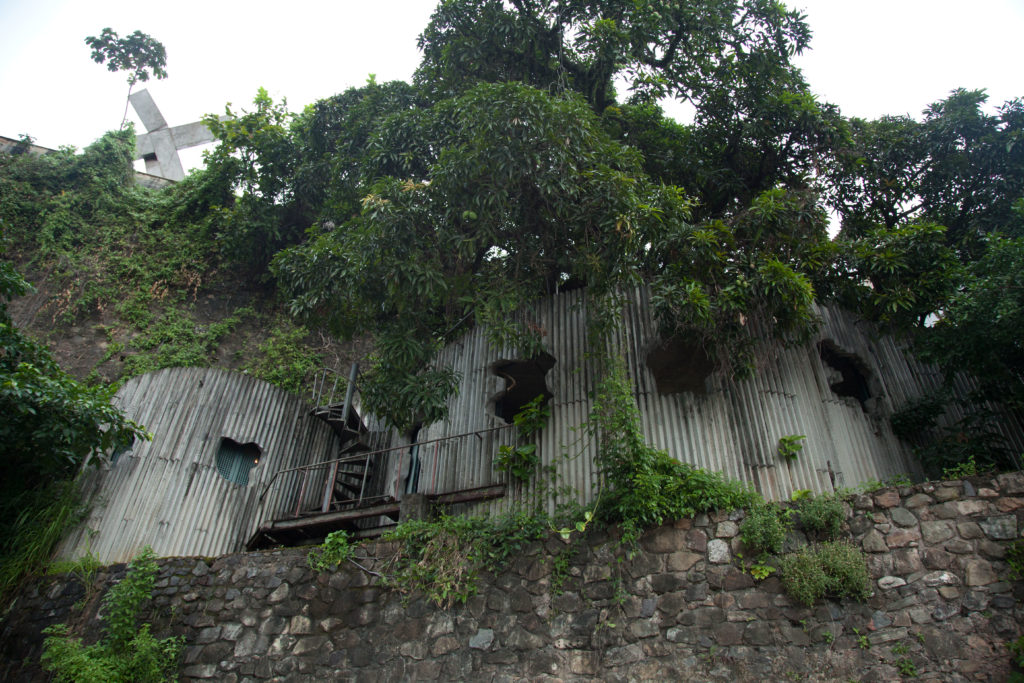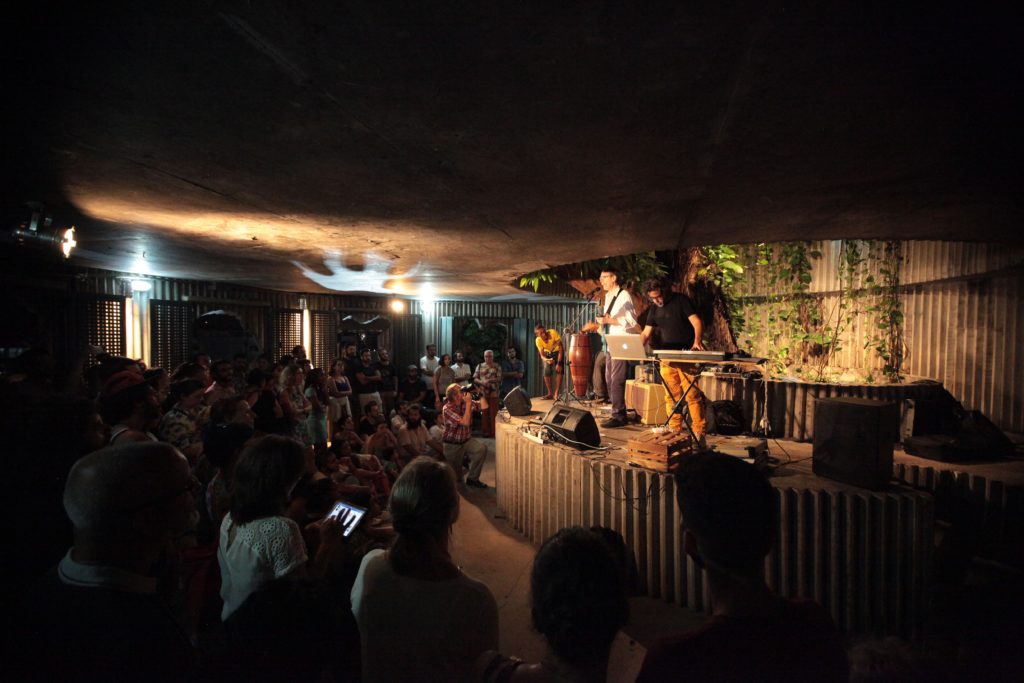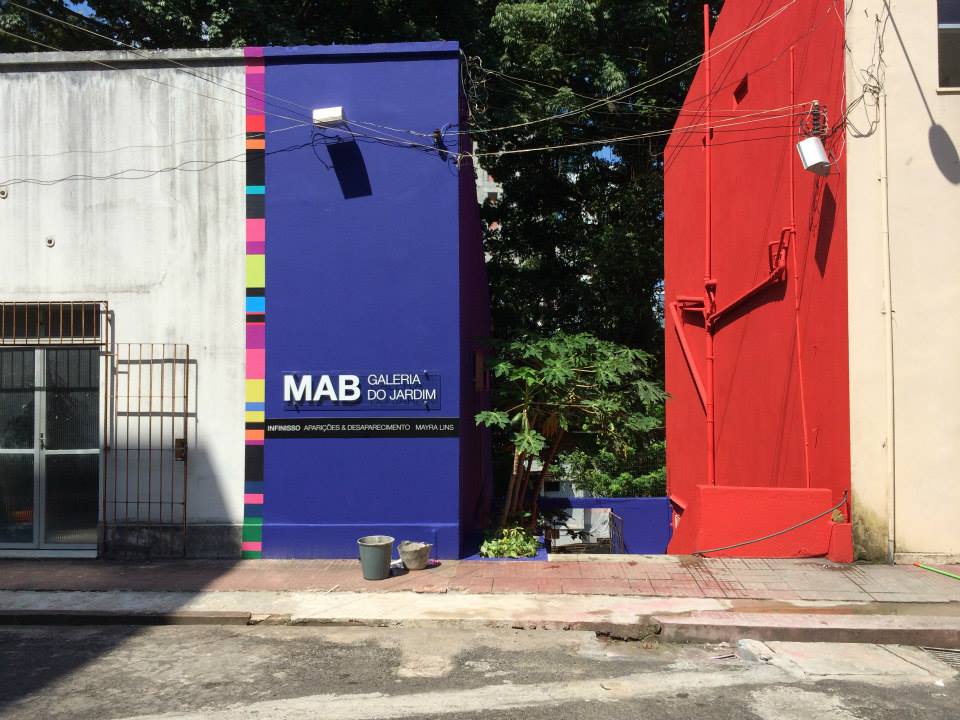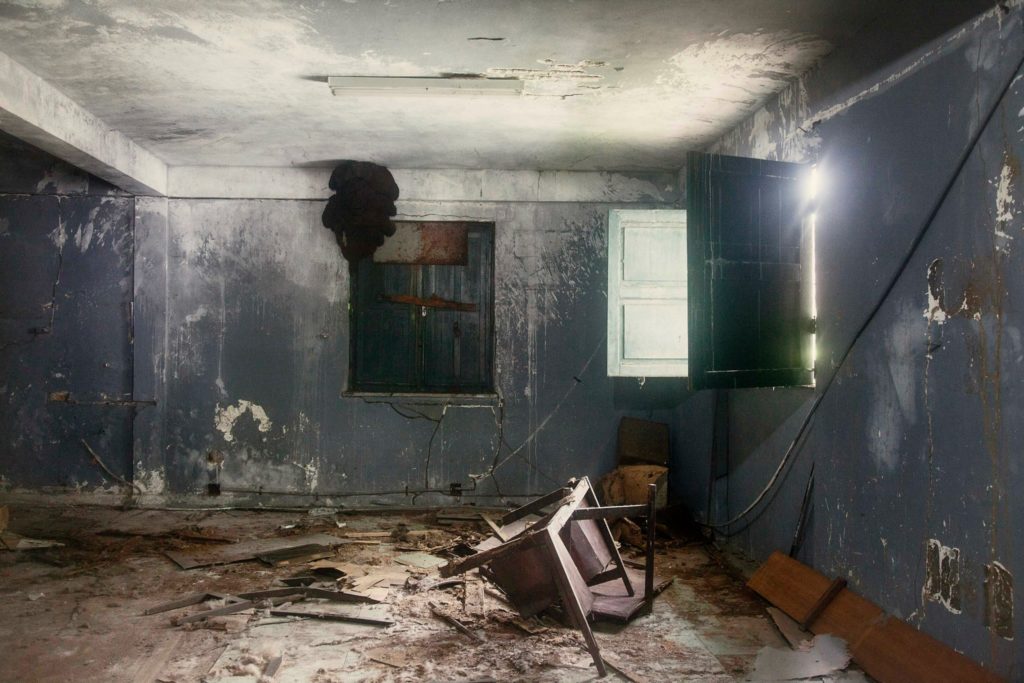Projecto Avita: In Conversation with Lanussi Pasquali
by Marina Resende Santos

Artists Joãozito Pereira, who passed away in 2017, and Lanussi Pasquali were the founders of Projeto Ativa, based in the city of Salvador, Brazil. Projeto Ativa identifies disused spaces in public areas of the city and proposes to activate them for contemporary art. Their most significant project was the occupation of the Coaty, a house designed by architect Lina Bo Bardi. Marina talked to Lanussi last November, when the artist arrived back from the São Paulo Biennial, and shortly after the election of Jair Bolsonaro to the presidency. They discuss Ativa, Lanussi’s upcoming collaboration with Chicago-based Jordan Martins, and the political climate in Brazil and thes relationship between art and politics.
Marina Resende Santos: What is the story of Projeto Ativa?
Lanussi Pasquali: Projeto Ativa was formed in 2014, but in a way, the practice already existed many years before we founded the project. João had started a practice of occupying and activating spaces in the 90s. But the project was born of a collaboration with the artist Mayra Lins, who invited us to produce her work in this abandoned space in the garden of Museum of Art of Bahia, in Salvador.
The director called us and said, “you are crazy; the house is a ruin.” But we said, no, we will transform it. So that is what we did. The money we could have earned as a company, we invested in the space.
That’s when the name “Ativa” came up. It was precisely the idea of activating, it is a term that comes from publicity but which I think makes a lot of sense in this case, where we are activating a place that is dormant. A place that exists, that is already public. So, we just need to give it some use—or to redirect its use.
Parallel to that, we did other things. For example, we moved the recording of a video to the Museu do Recôncavo Wanderley Pinho, a museum that is right by the bay and has been closed to the public since 2000. We did a conceptual architecture project proposing to change the Culture Council, which was this enormous space and very poorly used, right in the city center. We would transform it in another venue for contemporary art. The reform was never done. The name “Projeto Ativa” came up in the middle of all that, but everything that we did in this vein, with this perspective, we attribute to Ativa.
MRS: Tell me more about the Coaty occupation.
LP: There are five houses in the Ladeira da Misericórdia, a historical complex that was reformed by the architect Lina Bo Bardi. We occupied the Coaty, the Casa do Meio [House in the middle] and the Casa dos Três Arcos [House of the three arches], but we call the whole thing the Coaty occupation. The Coaty was inactive and shut, and no one knew who owned the building or who had the key. There was this Swiss art student visiting all of Lina’s projects in Brazil, and three days before she was meant to go back to Switzerland we learned that she had not been able to get in the Coaty house, and also decided that we wanted to do something with the space. So, we went after our contacts and found out that the building belonged to the Fundação Gregório de Mattos, which is the cultural office of the city of Salvador. We were able to get in. The office director kept one key, and we kept the other. We tried to keep the space alive, bringing curators and artists to see the space, a group from London who were re-editing Lina’s magazine project, a concert with Arto Lindsay. We then won a public grant to occupy the space for three months. The occupation involved visual arts, courses and workshops, and a few musical shows. And many people joined the project. Groups of musicians who did not have a space to play started to ask for the stage. We gradually took on other projects. In a way, Projeto Ativa, besides taking over the space, also tried to activate connections. There were groups of people doing different work that were not connected, and that we tried to bring together.
The first three months were so successful that the cultural office decided to hire us to occupy the space for six more months. During the second occupation, we focused on musical events, concerts, theatre, and performances that would really bring an audience to the space. And indeed, many people came. We thought we would have 30 people, and 300 came out. We thought there would be 300, and 1,500 showed up and took over the entire street. We were thinking that we had to bring a lot of people there, to mark this territory for other initiatives to occupy the space in the future—because the idea was not to stay. The idea was to open it up, to activate it, then leave. Then hopefully things would start to emerge on their own, other collectives would occupy the space with other proposals.
Today we have a network of occupied houses in reform in Salvador. They are of a different nature, they are privately owned, but the work being done in them is collaborative. There is the Casa Rosada, the Casa Charriot in the Comércio neighbourhood, or the Casa Preta, which already existed before we occupied Coaty. And they have really created a circuit of houses that are trying to understand themselves as occupied spaces, where one does not compete with the other but instead feeds the other. And I think this movement comes, too, from Coaty, from this year that we occupied Coaty. Which I think was a very beautiful time. The people who passed there, who frequented it, everyone feels that something has changed after that. Because it was a place where you didn’t have to consume anything. There were musical events of different genres, but everything was very good and of an experimental quality. You had poetry. And you had the space itself, which was pleasant to just sit and look at the landscape, or come to have a glass of water or a bottle of beer. It was a magical moment for the city. And thanks to the effort of many people, not just us. We take responsibility, but there were many people involved. And it goes beyond the limits of the space.

MRS: And what is in the space now?
LP: There is nothing there. The foundation does not have the resources to maintain it, or a project to create programming. The space is closed. They keep it a little cleaner, I will not say that it is abandoned. I am still trying to start some conversations with some contacts I still have in the mayor’s office.
MRS: We had a conversation about public funding for art and culture in Brazil, and you told me that you do not have good expectations for the Bolsonaro administration. He was also elected with a morally conservative agenda, in his own discourse and a large sector of his voters. People have talked about the possibility of censorship. I do not know how concrete that is for you.
LP: I fear that we are indeed going to suffer censorship. Take the two exhibitions that were closed last year. The Queermuseum was closed before the time in Porto Alegre because of a far-right protest. And there was a ballet dancer’s performance inside of an exhibition, for which he was naked. And this image circulated of child who touched his foot. That was a huge scandal—such conservatism—because it was a naked man. If it were a naked woman, they would not do anything. But since it was a naked man, they raised such a scandal. There was a performance by a travesti in which she plays as Christ as a travesti body, which was censored here in Salvador. And they keep on feeding ignorance with this perverse vision of what is the art object; as if the hate was in the artists and not in the intolerance of the Evangelicals. So, there is this very perverse product of the faith industry—because we cannot call that religion, it is an industry that takes advantage of people’s vulnerability, their emotional, intellectual and economic fragility, and produces what we have now. This terrifying scenario, where you now may be censored.
I saw a study where they learned that the cultural product that is most consumed by Brazilians, by far, were books. At first, you are surprised: books are the most consumed? That cannot be. But it is the Bible. Evangelical churches have taken the place of the State in the production of culture. They have Evangelical concerts. Evangelical bands, dances, theatre, any cultural sphere you can think of, you will find that Evangelical churches are doing it.
It is so hard. You talked about activists: the LGBTQ movement or Black activists. They have always been on the front line: the line of struggle and of slaughter. I think that is the appropriate word. They are slaughtered by the State. By the government. By intolerance. By the police. We organized an exhibition about Gregório de Mattos, the poet, and we created the Gregorian Thursdays in 2018. And we called the poetry collectives from the Salvador outskirts. It was so beautiful. These young people who declaim their poetry on the bus and organize poetry readings in their communities. There are collectives made only of girls, rap collectives. There are movements happening in the peripheries of the city that those who live in the center do not even know about. The revolution is happening. I think that is why, in the entire Northeast, [Bolsonaro] did not win. He did not win because this transformation across the Northeast—with Lula’s governments—was real. It was not fictitious, not made up for the media. It was a real transformation in the access to education, to scholarships, to a first job, to electricity, to welfare packages, and so on. A whole roster of benefits that have transformed this place. And they will not take away this transformation. It will go on.
But—indeed—I lament and fear for my Black friends, my gay friends. Because the threats have really risen. But there is also a beautiful movement coming. There is that campaign that has gone viral: “Nobody lets go of anybody” [“Ninguém solta a mão de ninguém”].

MRS: That was beautiful.
LP: Yeah, really, it is beautiful. I think this will make a big difference. Because, finally, we are having to face it. I was just in São Paulo and we talked about politics the entire time. We cannot not speak about it. We are evaluating, now, that in spite of the catastrophe that this government will be—because he is not only sexist, homophobic, and racist, he is also dumb. He is ignorant. He has no clue how to govern. But this moment worked to unmask that Brazil is not kind, Brazilians are not cordial, Brazilians are racist, sexist, and homophobic. The falling of this mask also has a positive side, because we wake up from that myth that in Brazil everyone is happy, joyous, and good people; that everybody hugs; that everybody is decent, and we are beautiful; God is Brazilian. It is a moment of coming to consciousness, really. A hard one. That our neighbors are fascists. And then, let’s go, let’s resist.
MRS: Tell me about this project now with Comfort Station, here in Chicago, which just received funding from the McArthur Foundation. You are doing an exchange project between Salvador and Chicago in the coming year. How is that going to be?
LP: this is an iteration of the “Perto de Lá” project, which we did with Jordan [Martins] in 2015, this time in Chicago. We are planning on doing it very organically. We are taking between eight and ten artists from here, that work in different areas. There is no commitment to producing any work there, but we are visiting studios, galleries, creating a dialogue among artists, and seeking to understand how things can work in different ways. We might put on a small exhibition, maybe even at Comfort Station, but that is not our main concern. The idea is to bring these seven people, or more, if we guarantee more funding, to spend ten days getting to know artists, studios, and creating situations for exchange. Seeing how a dancer from here can work with a musician from there, a printmaker from here visiting a printmaking studio there, working as a performer or a cook—I do not know, it remains organic and not pragmatic. But the prospect is good. I am quite excited. And then a group comes here from Chicago in 2020. Which is also promising.
MRS: And what would you do in Salvador?
LP: I think that their coming to Salvador, at this point, will allow them to understand how one makes art with such precarity. I think that if there is something we can teach, that might be it. How to make art, to keep believing in art amidst such precarity. I think that this is even a way for breathing, of getting some fresh air. We would visit poetry collectives, ateliers, meet artists, promote encounters between artists from there and from here. We will take them to the occupied houses—there are not many institutions that they could visit here. I hope that next year it will all be different—but the prospect is not particularly good. It will also be very much a mapping of the moment, whatever is going on at the moment when they come. And when it is all over, we want to put together a publication telling everything.
MRS: My last question is complicated, and maybe you have answered in our previous conversation about politics. I want to know if, in your opinion, artists and arts organizations have a role, a responsibility, or a capacity to act in the current political and cultural moment in Brazil?

LP: I think that art is political, or it is not art. When I speak about a political attitude, that does not mean necessarily a political theme. I have always had a very strong connection to politics. I have always read more of the political commentary magazines than art publications, although my work is so rooted in an individual studio practice, and my objects are so aesthetic. In the moment that we are living, I think it is simply necessary to take a political position. Not a position for a party, but a political one. Because there are people who will be directly affected. They will be killed because they are in the frontline of this struggle for existence. Especially in the peripheries. Especially in the Black rights movements. Especially in the LGBTQ movements. People who are already being slaughtered daily and will continue to be, but now these killings are somehow validated, or rather legitimated, by this politics of a leader [recently-elected Governor of Rio de Janeiro Wilson Witzel] who says that he will put elite shooters to “shoot them in their little heads.” The heads of the people in the favelas. We cannot pretend that this is not happening.
One role of the artist is to show that there is some fresh air in any situation. However hard it may be, however oppressive, it is possible for us to breathe a little. And this breathing comes to me through art because we create a new world. The artist, to me, is a creator of worlds. This given world is an invention, I am here to create a new world—of course, this sounds very pretentious. But it is the effort of a lifetime. That, for me is, art: both this aspect of creating opportunities for people to breathe and visualize new possibilities for life, new ways of life, and the capacity that art has to denounce. I value now, more than ever, this ability of art to denounce and expose, and this ability to create places that will embrace difference—that will create a way of moving in the world that is different from the everyday invented by this oppressive capitalism in which we live. And we, now, in Brazil, are living through a big lesson on how to survive such a challenging time.
I am not sure I have answered your question.
MRS: Oh, you did, very much, makes me want to talk for two more hours. You speak of privilege, of the pretension to create worlds, but there is something in that that is of the very human capacity for imagination. The human privilege of imagining—this capacity to create worlds that are different from the established.
LP: But if you stop and think about it, every popular movement in Brazil, every dance, every festivity, is a way of creating a new world. A group that gets together to bake bread is creating a new world. I speak of art, but I also think it has to do with the artist’s way of producing always a new encounter. It is a molecular revolution that gradually takes place, regardless of your awareness that that is art, that it could be used as art. It is a group that comes to clean somebody’s house, to repair something together. It is the baker who bakes bread with all his life force. It is those human activities done with a much greater investment, that is disconnected from capital. Without intention of getting economic and financial returns. It is another capital, it is affective capital, the capital of joy. Anything that you do that gives you joy. Be it dancing till the break of dawn. Till you take your shoes off.
This text was translated from Portuguese by Marina Resende Santos.